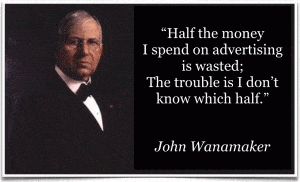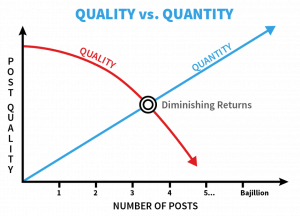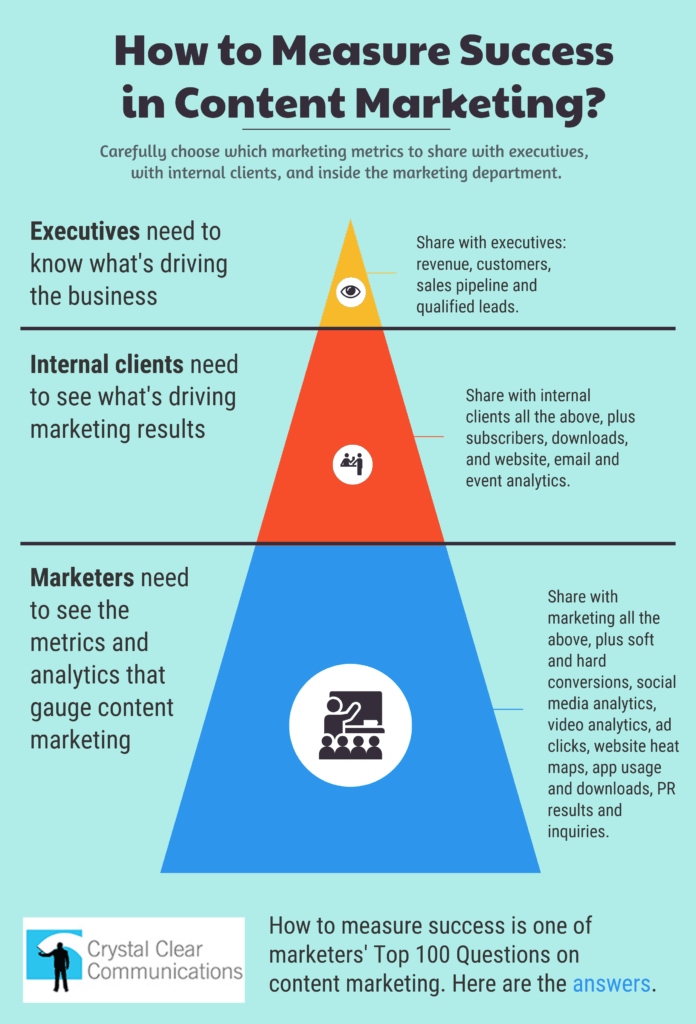
Top 100 Content Marketing Question: How to measure content marketing success?
10 insights on marketing measurement
Out of all the questions marketers ask about content marketing, the most frequently asked question is: How to measure success?
Many of the Top 100 Questions about content marketing concern measurement, found our analysis of more than 2000 questions about content marketing. Measurement is a big-picture question that applies not only to content, but also to all forms of marketing – digital, event, email, and other activities.

Marketers posed dozens of closely related questions, among them:
- What does success look like for content marketing?
- How do you measure the success of content marketing?
- How do you measure a content marketing program?
- How do you measure the effectiveness of content marketing?
- How do you measure the success of a content marketing program?
- How do you empirically track effectiveness?
- How can you determine the effectiveness of your content?
- How do you measure success and turn success into leads?
- How do you measure ROI & revenue influenced?
- How to track the business impact of content marketing?
- How to effectively track and report the success of content marketing?
- How do you effectively report on content marketing?
- How to measure content marketing performance?
- What are the best ways to measure the success/ROI of content marketing?
- How to measure success? Define success?
All your questions get answered in this mega-blog on content marketing measurement.

1. Begin with the why: What’s your purpose in measuring marketing?
Too many companies are fuzzy about a key point: Why do you need to measure marketing in the first place?
Measuring marketing can accomplish multiple goals, such as:
- Enable marketers to learn from results and improve the marketing mix, so that marketing produces more revenue and profits for the company over time.
- Help to prove the effectiveness of a specific marketing activity such as content marketing.
- Help to justify the existence of a marketing budget, headcount or department.
The best reason to measure marketing is #1. Learn from results so you can continuously improve marketing over time. That’s playing offense, which marketing needs to do.
When you measure mainly to prove effectiveness or justify a department’s resources or existence, you’re on your heels, playing defense. Measures for #2 and #3 may reflect doubts upstairs about the value of marketing, which can be hard to overcome with mere facts.
If you must measure to play defense, ok, but make sure you also play offense by including measures that enable you to make marketing more effective over time.
Measure all the measurable customer touch points. Look at marketing results as a system (rather than measuring each marketing function separately in its own silo).
Accept the fact that certain touch points create a lot of value but can’t be measured. Why? Because they happen out of any marketer’s line of sight – such as customer-to-customer conversations and emails people forward internally with a note to a friend.
Certain measures are difficult or expensive to execute (such as surveys on print publications), so make sure you first measure things that are most worth measuring, and provide the most insight per dollar. Don’t overspend in pursuit of the perfect measure.
When asked, “What is the return on investment from content marketing?” Robert Rose of the Content Marketing Institute counters with a question: “What’s the return on investment on a brochure?”
Truth is, no one knows the ROI of a brochure.
Marketing measurement has do’s and don’ts. Here are 3 don’ts:
- Don’t measure just for the sake of measurement. Don’t blindly measure what everyone else measures. Look for measures that matter, track them faithfully over time, adjust the mix and become more successful.
- Don’t let content marketing be held to a higher standard than other marketing activities. All marketing activities should be held to similar measurement standards.
- Don’t worry about the things that you can’t measure. There’s plenty you can measure and learn from.
2. What does successful marketing look like, in the eyes of executives?
Executives invest in marketing to grow the company and make money. They expect marketing to produce growth in sales and revenue, new customers and new deals. Rightly so.
Most executives don’t understand marketing metrics like page views, dwell time, bounce rates, email opens and click-through rates, or social followers. So, how do they measure marketing success?
Executives may calculate return on investment (ROI) for marketing. Here’s an ROI formula many use:
(Revenue – expense) = net profit
Total investment
For marketing, the problem with this ROI formula is that it applies to assets that are invested in, then sold off (such as companies and stocks). ROI takes in all the revenue and expenses to calculate a net profit, then divides net profit by total investment.

Most of what goes into an ROI formula lies well outside the domain of Marketing. To narrow down ROI enough to apply it sensibly to marketing, calculate a return on marketing investment (ROMI) using this formula:
(profit from sales growth – marketing expense)
Marketing expense
For example, say that successful marketing increases sales by $1 million and produces an additional profit of $100,000. Whether that was a good investment for the company depends on the amount of marketing expense:
- If marketing expense was $200,000, the company got a negative ROMI of 50%. That is, each $1 invested in marketing produced 50 cents in additional profit.
- If marketing expense was $100,000, the company broke even. The ROMI is zero. (Note: companies that enter or build a new market often consider that investment necessary and worthwhile, nonetheless.)
- If marketing expense was $50,000, the ROMI is 100%. Marketing produced $2 of incremental profit for each $1 invested in marketing.
- If marketing expense was $33,333, the ROMI is 200%. Marketing produced $3 of incremental profit for each $1 investment in marketing.
ROMI can lead to a mechanical mindset: the higher the profit from sales growth, and the lower the marketing expense, the better. That can become dangerous.
Why? Because some executives follow the mechanical mindset out the window. They cut marketing expense, again and again, sometimes leading a company into a death spiral.
Here’s how to simplify the marketing success measure even more. Find a simpler formula that works for marketing in your company.
For example, I worked with a chief financial officer (CFO) to come up with this marketing formula. For each additional $1 in marketing expense, the Marketing Department needed to produce $3 in additional revenue. That’s what it took for the company to achieve profitable incremental growth.
This simple guideline helped marketing choose profitable investments. Everyone in the Marketing Department understood exactly what we needed to do.
For more ideas on how to measure content marketing success, subscribe to our blog.
What marketers really need is a success measure everyone can understand. That’s why ROI or ROMI may not be the best measure for content marketing.
Marketing is successful whenever it helps the company reach its objectives and goals – only one of which is a financial return. Many other valid business objectives such as brand awareness, customer retention, quality of user experience, and customer satisfaction may not appear in a ROMI calculation.
The right things to measure in marketing must connect directly to the CEO’s and company’s objectives. That’s the key to finding marketing metrics executives will heed and respect.
3. How much credit should content marketing get for revenue growth?
How much credit should content marketing get for sales and profit growth, compared with advertising, PR, trade shows, and other marketing activities?
Most companies make the mistake of measuring each marketing activity separately, in its own silo – rather than measuring marketing and PR activities together, as a whole.
Separate marketing measurements often lead to the inevitable – multiple functions all taking credit for the same growth. If 3 or 4 groups each claim to have generated the same $100,000 in additional profit, you face the problem called “attribution error.”

As marketing pioneer John Wanamaker said a century ago, “Half the money I spend on advertising is wasted. The trouble is I don’t know which half.”
Attribution error means knowing that $100,000 in additional profit was generated, without knowing exactly which marketing activities led to that growth. To work around the attribution problem:
- Some companies attribute results to the “first touch,” the first proven touch point where a customer interacted with the company (such as an email or web page).
- Other companies attribute results to the “last touch,” the last thing a customer did before making a purchase (such as an ebook download).
- But neither the first touch nor the last touch tells the whole story, since each marketing and sales touch point helps move the customer forward to a purchase.
- Key touch points such as word of mouth and emails forwarded inside a company are pretty much invisible to companies. There’s not a good way to measure them.
It’s rarely possible to attribute marketing success to any one touch point. Attributing sales to only the last touch point is like giving all the credit to a basketball player who scores a basket, without taking into account the other players, the offense’s execution or the great pass that made a basket possible.
It's a humbling truth: you may not always be able to explain exactly which part of marketing produced a given sale. But remember, seeking the perfect explanation misses the purpose of measurement. The point is to learn and learn how to grow sales profitably over time.
Measure the entire marketing system to see how it’s working. Don’t try to measure marketing piecemeal. A piecemeal approach renders a distorted, misleading picture.
Avoid snapshot measurements. You can’t learn much from a measure of marketing performance over a limited time period like one month or one quarter. Marketing measures work best when they reveal patterns that emerge over longer periods of time -- multiple quarters or years.
The best marketing measures are documented consistently over at least 2 years, ideally plotted as a fever chart comparing year 1 with year 2. A 2-year fever chart enables you to find out how much seasonality contributes to or detracts from overall results. And it may show which content users want most in which seasons.
4. To start, measure content where the measurements are most straightforward.
If content marketing is new to your company, hunt for a greenfield or orphan opportunity to prove content marketing works. Here's how.

Choose a market to do a pilot test of content marketing, one where all of the sales growth could be attributed to content. (See “How to sell the value of content marketing to Sales?”)
It’s straightforward to measure content marketing success when marketing works in a greenfield, a new area where content marketing is used alone, without other marketing activities. A new company, a new product, and a new market launch can provide marketers with greenfield opportunities.
You can also make marketing measurement straightforward by supporting an orphan, a product, product line or market where no marketing has been done in the past year. When you start up content marketing for an orphan and succeed in growing sales, all of the additional sales can be attributed to content marketing.
If you have only a limited time to prove the effectiveness of content marketing, choose products with short sales cycles – 1 to 3 months. Why? If you choose a product that takes 18 months to close a sale, there’s no way content marketing can meet expectations in the first year. And that may test your executives' patience.
5. Which content marketing metrics should marketing measure?
Measure ROMI, revenue, sales pipeline, customers and deals won. Present these metrics as evidence to executives. Make the results quick: boil them down to a 1-page report or 1 slide that builds.
To improve content marketing results over time, you need to perform granular marketing measurements behind the scenes:
- Website and SEO metrics such as: search rank, keywords, website traffic, time on a webpage, bounce rate, conversion path. See “Content Marketing Metrics: 10 Easy Ways to Measure Effectiveness,” a blog by Barry Feldman.
- Email metrics such as subscribers, deliveries, open rates, click-through rates. See “Email Analytics, The 6 Email Marketing Metrics and KPIs You Should Be Tracking,” a blog by Lindsay Kolowich.
- PR metrics such as share of desirable coverage, conversions, cost-effectiveness. See “Katie Payne’s 5 Data Points You Need in Your PR Dashboard,” a blog by Steve Goldstein.
- Event metrics such as new leads, social media reach, new customers, customers reached with product demonstrations. See “The 4 Most Important Metrics for Measuring Your Trade Show Marketing ROI,” a blog by Rachel Sprung.
- Social media metrics such as followers, likes, shares, user-generated content. See “16 Key Social Media Metrics to Track in 2023,” a blog by Christina Newberry.
- Brand value, as calculated under UK accounting rules. See “Brand Valuation – What It Means and Why it Matters,” a white paper from Brand Finance.
To sum up, measure everything that’s feasible and practical to measure. You may start out by rounding up as many as 30 or 40 measures.

At first, a dashboard with 30 or 40 marketing metrics will appear as complicated as the cockpit of a commercial airliner. Allow yourself time to get used to all the dials and gauges, learn which ones move in tandem, then hypothesize and experiment to improve overall results.
Assign a manager to round up all the metrics from each marketing and PR function and produce a monthly report. After the process is defined, you may be able to turn a lot of the work over to an AI robot.
If you are fortunate enough to have the luxury of a data analyst or data scientist who can help with measurement, apply their skills.
Bring the whole marketing team together to discuss marketing metrics regularly – monthly or quarterly. Invite individuals to develop their own separate hypotheses about why certain measures are trending up or down. When you have a set of competing hypotheses in hand, you can test them to learn which hold up and which fail.
Through this process – discovering data, hypothesizing and testing – you gradually find out which measures are most important.
In particular, you’ll find out which measures best foreshadow growth in revenue, sales and customers. Then you can adjust to manage a smaller set of metrics – 10 to 12, plus or minus – that enable you to fine-tune marketing.
When you seek measurement help from third-party consultants, be careful. Many experts set out to mystify measurement.
They talk over your head. They make measurement seem too complex for mere mortals to understand. If a consultant can’t walk you through the measurement process and make it reasonably understandable, they may not be the right fit for your needs.
Find the simplest set of measures that work for your company. The quality of any marketing measurement reflects:
- The quality of the questions you ask
- The hypotheses you test
- The willingness to accept the data, no matter what it says – even when it doesn’t reinforce your existing beliefs.
As David Ogilvy noted long ago, most clients use to research the way a drunk uses a lamppost – more for support than illumination.

The challenge of marketing measurement is to seek true illumination. Over time, as you learn, measuring marketing can become as easy and intuitive as the dashboard of your car.
6. How do you measure content quality?
Measures that gauge the quality of content are often overlooked. They’re important because, in the eyes of your customers, quality beats quantity in content marketing.

Consider these measures to apply to content marketing:
- Consistency of message. Whether you tell your story in digital, print or live media, the message needs to be completely consistent. Neuroscience shows that only consistent messages have a chance to break through to audiences. See the blog “Who Needs Better Messaging?”.
- Test the scannability of content. On average, users read only about one-fourth of the text on a webpage – so give them pictures, headlines, subheads, charts, graphs, bullets and elements they can scan for answers.
- Test the readability of text. Use Microsoft Word or a website such as readabilityformulas.com to test readability. The lower the grade level of a text, the larger the audience who can read it and comprehend it. That’s especially important if you address global audiences in English.
- Check headlines for emotional marketing value (EMV). Headlines that breakthrough are emotional, ask questions, include numbers and use power words. See blog, “4 Ways to Use Power Words to Supercharge Your Message.” Test the EMV of headlines by using the free tool at aminstitute.com/headline/index.htm.
- Audit content to find out how competitive it is. Choose your top 3 to 6 competitors and hire an outsider to discover, compare and analyze everyone’s content. Content audits show how competitive your content is, identify “white spaces” you can address that competitors don’t, enable the development of differentiated content, and help you outsmart competitors.
7. How much long-term value does your content create?
Think long-term when you think about content marketing. Content is a long-term game.
You will need at least 1 to 2 years to prove all the value your company can get from content. If your company lacks the patience to give content enough time to work, it’s probably not a good candidate for content marketing.
Content marketing is all about teaching, as Marcus Sheridan observes in his book They Ask You Answer. Why? People like teachers more than salespeople.

Maximize content marketing value by becoming the best teacher.
Here’s an idea for how to become the best teacher in your field: Capture your customers’ top questions, text-analyze them, and rank the 100 most important customer questions.
Write one webpage to address the questions on each topic. Provide the best answers on the Internet for people’s questions on each topic.
Answering each of your customer’s top 100 questions creates tremendous value, especially when you work hand in hand with the Sales Department. As Sales starts to use your answers to address customers’ questions, you build a stronger alliance.
A question analysis inspired me to write this blog on how to measure content marketing success. How to measure success? is the #1 question out of more than 2000 questions that marketers asked in my content marketing workshops.
Evaluate content by asking: Does it help grow the market?

Great content grows markets, as the Michelin Guide did when it was first published in 1900. At a time when there were only 2,900 cars in France, the Michelin Brothers boldly printed 35,000 copies of the Michelin Guide.
By showing people all the places they could go, the Michelin Guide inspired more people to buy cars. Thus the Guide enlarged the market for autos and tires, enabling Michelin to expand its bicycle tire business into a new market, auto tires.
Sometimes the value of content marketing shows up anecdotally. Capture anecdotes like these, because they’re the kinds of stories CEOs love to hear:
- An Executive VP of Sales told me, “I see our company magazine in every customer’s office I go in. It’s everywhere. How do you do that?”
- Thought-provoking content for Tellabs led to the company’s first inbound calls from prospective customers such as Telefonica’s Chief Technology Office and Google.
- When an orphan line of business that's been flat-lining begins to grow again, other salespeople will ask for your secret sauce -- content marketing.
8. Is the amount of content you produce a valid measurement?
Is output a valid marketing measure? Some marketers who ask about measurement are looking for permission to use the simplest metric of all: output.
They ask: How many blogs per month do I need to write?
Measuring output says something, but don’t kid yourself – it’s not really a useful marketing metric. Don’t count content the way factories count widgets.
Robert Rose advises producing the minimum amount of content that will have the maximum impact on the audience. That's really good advice.
9. It’s easy to poke holes in any measurement scheme.
No marketing measurement system is perfect. But a good measurement system, used regularly over time, will you teach a lot about how to make content even more successful.
Successful measurement systems require a strong process, good data, and a thoughtful model, plus an occasional leap of faith.
Somewhere in the wheels and cogs of measurement, you’ll probably encounter customer behaviors that are hard to prove through marketing metrics alone.
That’s when you’ll need to take a leap of faith. Leap!
10. Report to executives only about things they understand and care about.
Don’t bring executives a pile of reports on arcane marketing metrics such as bounce rates, social followers, email open rates and so forth.
They won’t understand all that. They won’t care. And you’ll get frustrated.
Bring execs the metrics that answer questions they care about. Did marketing:
- Increase sales and revenue?
- Help win new customers and deals?
- Produce profits from marketing investments?
- Help the company and CEO meet their objectives?
Here's an infographic that gives you a new way to think about which measures to share with each internal audience:

To address your #1 question on content marketing – How to measure success? – keep these 10 insights in mind:
- Measure with a clear purpose – to learn how to do content even better.
- Measure marketing as it’s seen through the eyes of executives, to grow the business.
- Attribution is imperfect. Watch larger trends, not individual data points.
- Start content marketing where it’s most straightforward to measure.
- Use marketing metrics as internal diagnostics, in order to maximize results.
- Measure the quality of content before you publish.
- Measure the long-term value of content to the business.
- Don’t consider output alone to be a valid marketing measure.
- No marketing measurement system is perfect.
- Only report to executives on things they care about: revenue, customers, deals, sales pipeline. Avoid reporting arcane marketing metrics.
By the way, here’s an intriguing blog, “5 bullshit metrics you need to stop using to measure content marketing success,” by Daniel Hochuli.
It pokes holes in 5 common metrics: impressions, ROI, bounce rate, benchmarks, and the funnel. What I like about Hochuli’s blog is that it questions conventional wisdom about measurement and encourages people to think critically. Both can lead to better results.
For more ideas on how to measure content marketing success, subscribe to our blog.
What are your thoughts about how best to measure success in content marketing?





